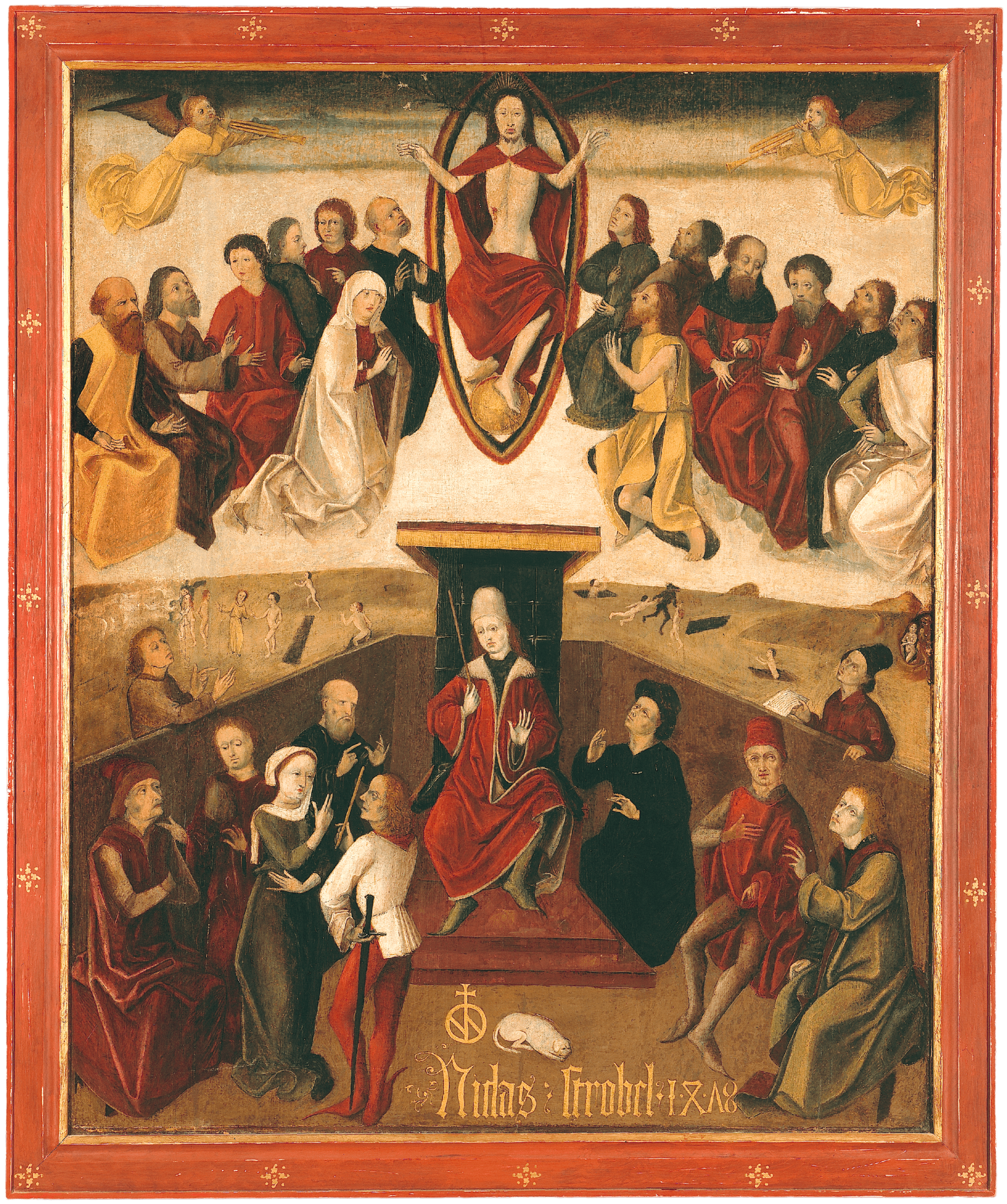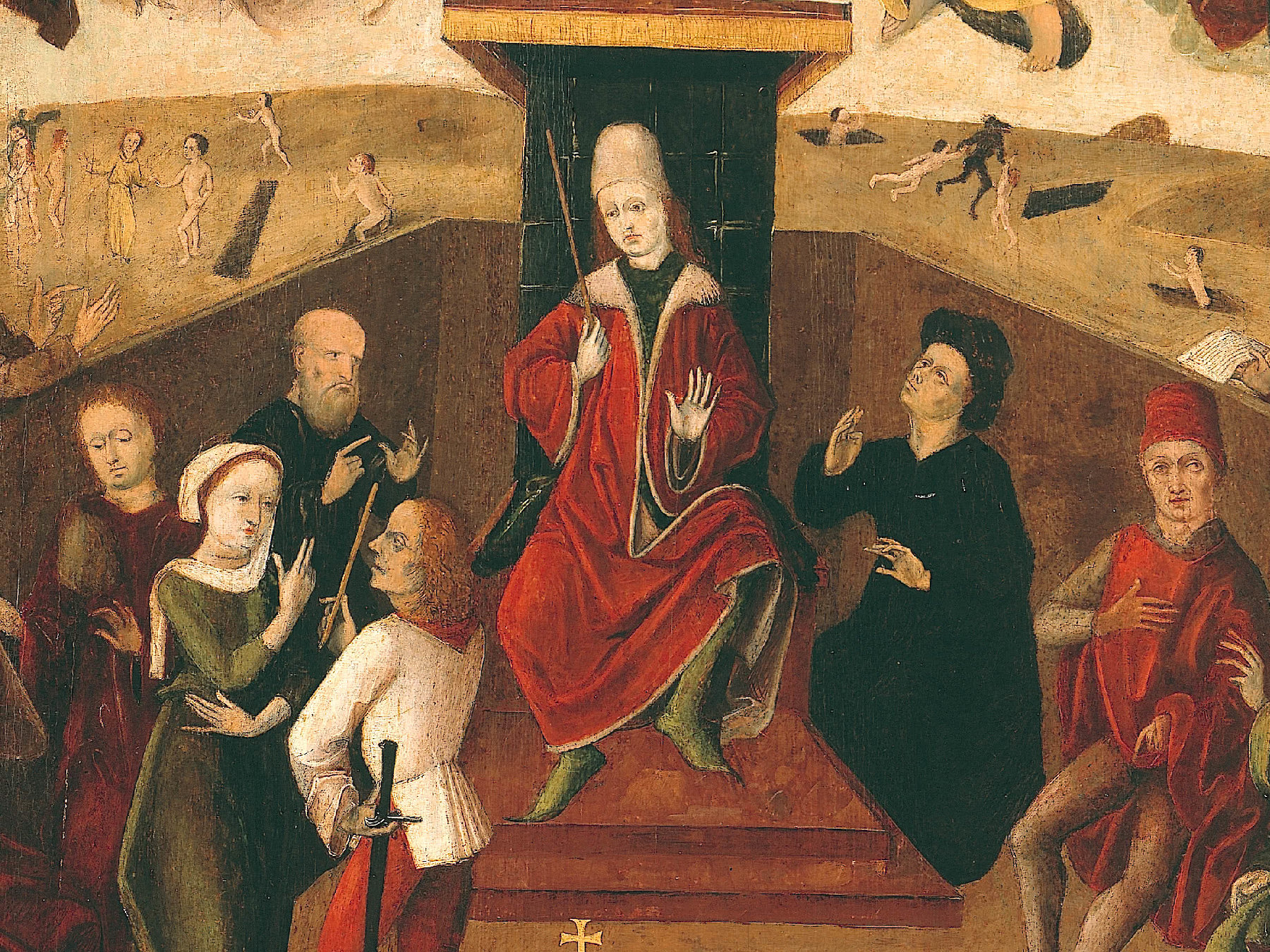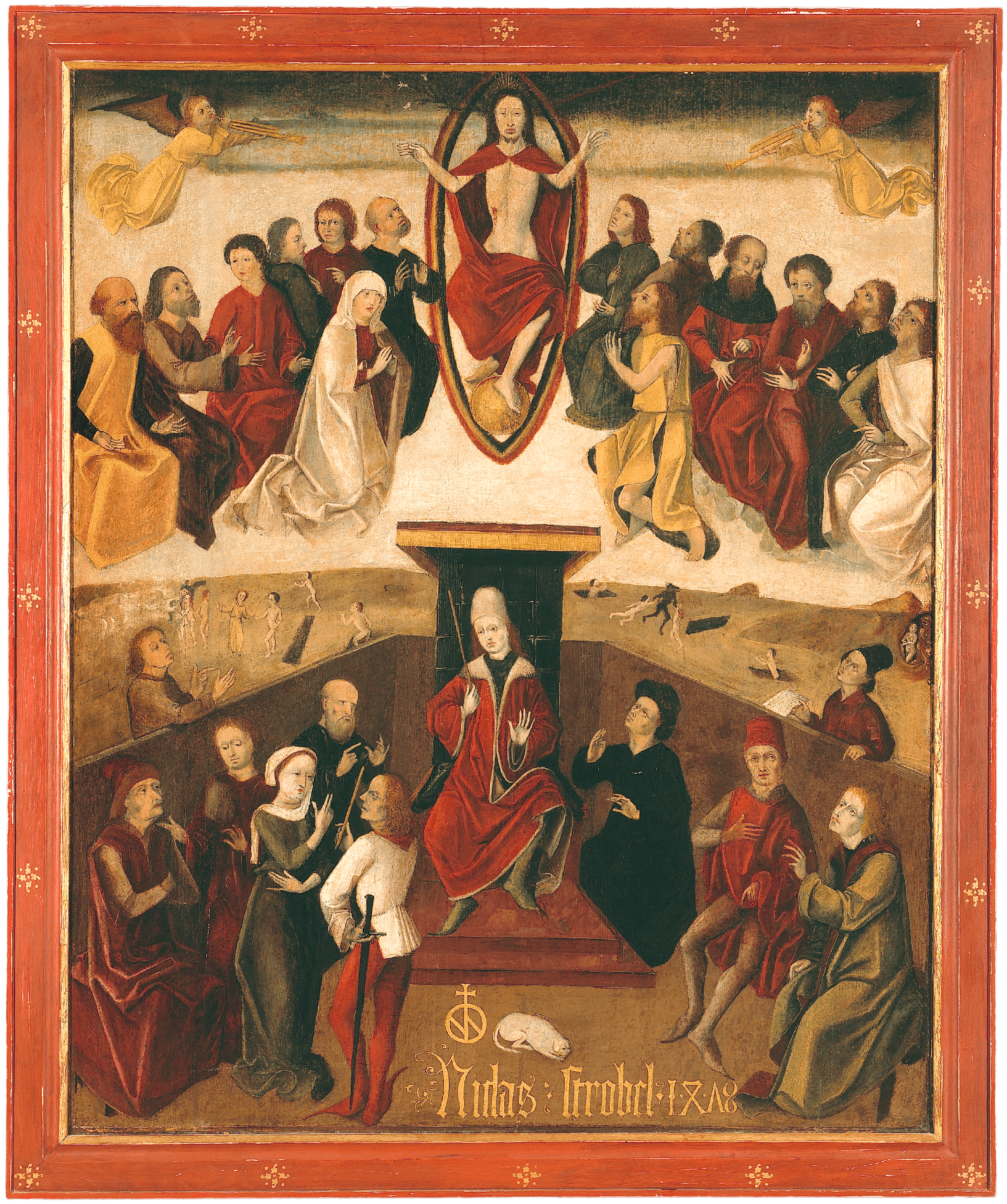
A court usher with stick and sword is putting a witness on oath. At that time, women were not allowed to stand before the court on their own account and had to be accompanied by a man.
City Judge Strobel, who can be recognised by his official attire and the judge’s stick, shows up in the centre of the image. He is the symbolic figure of self-confident civic jurisdiction. Two lay judges (jurymen) are sitting next to him.
City Judge Niclas Strobel was a master butcher by trade—which can be seen in the guild symbol. His wealth allowed him to hold the fixed-term offices of the city judge and the mayor several times.
The dog resting in front of the City Judge stands for the biblical figure of King Solomon. The “Solomonic judgment”, which is named after him, refers to a particularly wise and fair judgment.
The parties to the dispute and/or their representatives are standing outside the “Schranne”, a legally protected area separated by a wooden wall. The document, maybe a contract, may hint at a dowry dispute.
Gerichtstafel des Stadtrichters Niclas Strobel (Court Tableau of the City Judge Niclas Strobel) Alpine painter, 1476
The Legal Autonomy of the City
The panel painting, dated 1478, has two narrative levels. On the one hand, it presents the city judge of Graz, Niclas Strobel, in the exercise of his office. It shows the court usher taking the oath of a (female) witness and the jury discussing the verdict to be decided. This makes it one of the oldest visual documents of municipal legal autonomy in Europe. On the other hand, the representation illustrates the religious world view of the Middle Ages. A heavenly scene of judgment takes place over the worldly one, because in the end all men have to answer to God.
Oil/tempera on spruce wood
frame (20th c.): 131,4 × 109,2 × 6,7 cm
Graz Museum
The Schranne
The Schranne (a protected space of jurisdiction which is separated from the outside space by a wooden wall) represents the place and perimeter of worldly judgment. It defines both the scene of the trial and the judicial district. Graz received the princely privilege of independent jurisdiction in the course of the expansion of the city under the Babenbergs in the early 13th century. In 1281, King Rudolf I of Hapsburg confirmed the freedom letter of Emperor Frederick II to Graz. From then on, the right of settlement, liberation of the city from tolls as well as high justice including capital punishment administered by the city court applied.

City Judge Niklas Strobel
City judge Niklas Strobel (aka Strobl) is enthroned in the centre of the painting. The clear pictorial structure and hierarchical arrangement illustrate the power and prestige of the city’s highest authority to the viewer. City judge Strobel is directly related to Christ, the judge of the world. Both act as representatives of absolute decision-making power, accepted by the accompanying figures. Strobel, who himself commissioned the painting, thus represents the growing urban self-confidence of the time. Rights and privileges corresponded to the will of God and were not to be owed to the grace of the sovereign.
Bourgeois Self-confidence
In addition to the name, Niklas Strobel, and the year, 1478, the representation also refers to the guild membership of the city judge. Strobel was a member of the butchers’ guild, which mainly settled in the so-called “Kälbernes Viertel” (literally: quarter of calves) between the Mur and the city wall (in the area of today’s upper Neutorgasse) in the 15th century. Due to their great importance for the city’s food supply, the butchers were among the most influential guilds in Graz, alongside the bakers.
Taking the Oath
In the foreground, the Fronbote (court usher)—marked by his stick and sword—is taking the oath of a (female) witness. Women were not allowed to stand before court on their own and had to be accompanied by a man. The biblical credo and model of the medieval social order becomes visible in this: Women are subordinate to men; they must exercise a servant function.
The Heavenly Court
The Heavenly Court is sitting on top the city court. Reminiscent of tympana representations in medieval cathedrals, Christ as world judge (“Majestas domini”) takes centre stage. Together with Mary and John the Baptist, the intercessors of humanity, Christ forms a triangular composition (“deesis”). He is symmetrically flanked by the twelve apostles. Angels are blowing the horns bringing the dead to life. Representations of the Last Judgment were omnipresent references to the Second Coming of Christ on earth in the Middle Ages: Judgment Day, when all people must give account to God and are either granted heavenly salvation or condemned to eternal damnation.
Enforcement of the Heavenly Judgment
Beyond the Schranne, the judgment of the Heavenly Court is enforced on the dead raised by angels. Their nakedness is on the one hand a sign of the equality of all human beings before God and, on the other, an expression of human (mainly female) sinfulness. The ones redeemed to eternal life form a group. The damned are dragged into the hellmouth by devil figures. The dramatic, yet easily readable imagery announced to the mostly illiterate population the omnipresence of death and imminent divine judgment.
The Wisdom of Solomon
At first glance, the crouching dog in the foreground seems to serve only as a “picture filler”, but medieval paintings contain a variety of symbolic statements. Thus, the dog iconographically stands for the wisdom of King Solomon, the just judge in the Old Testament.
History of the Object
The Image of the City Judge is one of the oldest and most important objects of the GrazMuseum. The painter of the panel painting from 1478 is unknown. The object is a rare testimony of municipal jurisdiction in the European late Middle Ages: It represents a pictorial type of which only four examples are known worldwide. In 2017, the Image of the City Judge of Graz was united for the first time with the other representations in the Groeningemuseum in Bruges, Belgium.
The panel painting poses special challenges for presentation and conservation. Materials and technique—tempera on spruce wood—require certain climatic conditions. A custom-made, sealed frame with UV glass on the front guarantees a constant microclimate and thus the protection of the painting during exhibitions.
